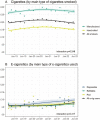How has Expenditure on Nicotine Products Changed in a Fast-Evolving Marketplace? A Representative Population Survey in England, 2018-2022
- PMID: 37226851
- PMCID: PMC10439490
- DOI: 10.1093/ntr/ntad074
How has Expenditure on Nicotine Products Changed in a Fast-Evolving Marketplace? A Representative Population Survey in England, 2018-2022
Abstract
Introduction: In the last 5 years, there has been a dramatic shift in the types of nicotine products being purchased. This study aimed to estimate how much users spend on types of cigarettes and alternative nicotine products (e-cigarettes, nicotine replacement therapy (NRT), heated tobacco, and nicotine pouches) and describe changes between 2018 and 2022.
Aims and methods: Monthly representative cross-sectional survey in England. 10 323 adults who smoked cigarettes or used alternative nicotine reported their average weekly expenditure on these products, adjusted for inflation.
Results: Smokers spent £20.49 [95% CI = 20.09-20.91] on cigarettes each week (£27.66 [26.84-28.50] and £15.96 [15.49-16.28] among those who mainly smoked manufactured and hand-rolled cigarettes, respectively), e-cigarette users spent £6.30 [5.99-6.55] (£8.41 [7.17-9.78], £6.42 [5.58-7.39], and £5.93 [5.64-6.30] among those who mainly used disposable, pod, and refillable devices, respectively), NRT users £6.11 [5.53-6.69], and heated tobacco users £13.87 [9.58-20.09]. Expenditure on cigarettes grew by 10% from September 2018 to July 2020, then fell by 10% from July 2020 to June 2022. These changes coincided with a 13% reduction in cigarette consumption and a 14% increase in the proportion mainly smoking hand-rolled cigarettes. Expenditure on e-cigarettes was stable between 2018 and late 2020, then rose by 31% up to mid-2022. Expenditure on NRT increased slowly in 2018-2020 (+4%) and more quickly thereafter (+20%).
Conclusions: Inflation-adjusted expenditure on cigarettes has fallen since 2020, such that the average smoker in England currently spends the same on cigarettes each week as in 2018. This has been achieved by smoking fewer cigarettes and switching to cheaper hand-rolled cigarettes. Expenditure on alternative nicotine has increased above inflation; users spent around a third more on these products in 2022 than between 2018-2020.
Implications: People in England continue to spend substantially more on smoking cigarettes than using alternative nicotine products. The average smoker in England spends around £13 a week (~£670 a year) more than people using only e-cigarettes or NRT. The average expenditure on manufactured cigarettes is double that of hand-rolled cigarettes.
© The Author(s) 2023. Published by Oxford University Press on behalf of the Society for Research on Nicotine and Tobacco.
Conflict of interest statement
JB has received unrestricted research funding from Pfizer, which manufactures smoking cessation medications. LS has received honoraria for talks, an unrestricted research grant, and travel expenses to attend meetings and workshops from Pfizer, and has acted as paid reviewer for grant awarding bodies and as a paid consultant for health care companies. All authors declare no financial links with tobacco companies or e-cigarette manufacturers or their representatives.
Figures


Similar articles
-
Expenditure on smoking and alternative nicotine delivery products: a population survey in England.Addiction. 2019 Nov;114(11):2026-2036. doi: 10.1111/add.14709. Epub 2019 Jul 2. Addiction. 2019. PMID: 31243842 Free PMC article.
-
Do Smokers' Perceptions of the Harmfulness of Nicotine Replacement Therapy and Nicotine Vaping Products as Compared to Cigarettes Influence Their Use as an Aid for Smoking Cessation? Findings from the ITC Four Country Smoking and Vaping Surveys.Nicotine Tob Res. 2022 Aug 6;24(9):1413-1421. doi: 10.1093/ntr/ntac087. Nicotine Tob Res. 2022. PMID: 35368082 Free PMC article.
-
Is dual use of nicotine products and cigarettes associated with smoking reduction and cessation behaviours? A prospective study in England.BMJ Open. 2020 Mar 15;10(3):e036055. doi: 10.1136/bmjopen-2019-036055. BMJ Open. 2020. PMID: 32179563 Free PMC article.
-
Factors influencing the uptake and use of nicotine replacement therapy and e-cigarettes in pregnant women who smoke: a qualitative evidence synthesis.Cochrane Database Syst Rev. 2020 May 22;5(5):CD013629. doi: 10.1002/14651858.CD013629. Cochrane Database Syst Rev. 2020. PMID: 32441810 Free PMC article.
-
Impacts of EU Tobacco Products Directive regulations on use of e-cigarettes in adolescents in Great Britain: a natural experiment evaluation.Public Health Res (Southampt). 2023 Jun;11(5):1-102. doi: 10.3310/WTMH3198. Public Health Res (Southampt). 2023. PMID: 37452656
Cited by
-
Nicotine strength of e-liquids used by adult vapers in Great Britain: A population survey 2016 to 2024.Addiction. 2025 Mar;120(3):468-482. doi: 10.1111/add.16576. Epub 2024 Jun 19. Addiction. 2025. PMID: 38897583 Free PMC article.
-
Trends in non-daily cigarette smoking in England, 2006-2024.BMC Med. 2024 Oct 24;22(1):426. doi: 10.1186/s12916-024-03635-1. BMC Med. 2024. PMID: 39444038 Free PMC article.
-
A Scoping Review of Behavioural Studies on Heated Tobacco Products.Cureus. 2024 Jul 30;16(7):e65773. doi: 10.7759/cureus.65773. eCollection 2024 Jul. Cureus. 2024. PMID: 39211653 Free PMC article.
-
Trends in long term vaping among adults in England, 2013-23: population based study.BMJ. 2024 Jul 17;386:e079016. doi: 10.1136/bmj-2023-079016. BMJ. 2024. PMID: 39019543 Free PMC article.
-
Prevalence, safety, and role of nicotine pouches in smoking cessation among smokers and the public in Saudi Arabia.Sci Rep. 2025 Aug 13;15(1):29758. doi: 10.1038/s41598-025-15070-0. Sci Rep. 2025. PMID: 40804318 Free PMC article.
References
-
- HM Revenue and Customs. Changes to tobacco duty rates.2021. https://www.gov.uk/government/publications/changes-to-tobacco-duty-rates...
-
- McCaul KD, Hockemeyer JR, Johnson RJ, et al. . Motivation to quit using cigarettes: a review. Addict Behav. 2006;31(1):42–56. - PubMed
-
- Chaloupka FJ, Yurekli A, Fong GT.. Tobacco taxes as a tobacco control strategy. Tob Control. 2012;21(2):172–180. - PubMed
Publication types
MeSH terms
Substances
Grants and funding
LinkOut - more resources
Full Text Sources
Medical

